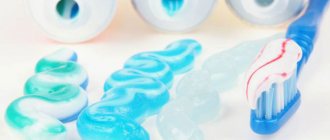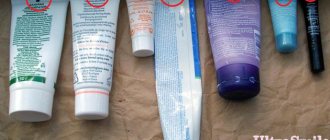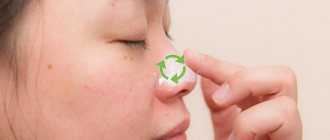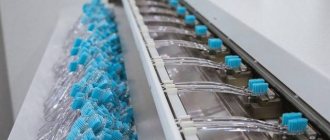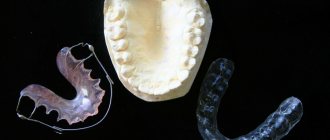Labeling on packages of toothpaste and cream
First, it’s worth debunking one popular myth about toothpaste labeling. At the bottom, at the very end of the tube, there are small multi-colored marks: red squares, green, blue, black stripes. What do these icons mean? For a long time, there was false information on social networks that color markings in the form of a square or strip on tubes, as on other cosmetic products and creams in tubes, help determine quality.
The myth says that:
- a green stripe mark means that the product is natural and safe,
- a red stripe supposedly means that the paste contains components of both chemical and natural origin,
- color coded black or blue - this product is completely chemical and hazardous to health.
The color of the marking does not in any way indicate the quality and safety of the cosmetic product. The notorious stripes have a different meaning and are intended for completely different purposes.
What are these stripes?
These colored stripes are called phototags. They have nothing to do with the composition of the product, but are needed exclusively for production. In order to understand where they come from, you need to understand the production of these tubes.
The color of the photo tag is selected from those colors from the Pantone palette that are used in the packaging design of a particular toothpaste or cream. It is needed for the correct orientation of the tube in the tube filling machine. This mark is read by a light beam, and for the sensor to recognize it, the color must contrast as much as possible with the background color. So, for a white tube the most contrasting color will be black, and for black - white or beige. If the design contains black, then both the photo tag and the barcode will be black; if there is no black in the design, then the maximum contrast color relative to the background is assigned.
What else are photo tags used for?
Photo marks are also needed for the following production reasons: horizontal - for precise cutting of the laminate sheet in height (when printing on a rolled laminate sheet); vertical - for precise positioning when soldering the tip of the tube (so that the solder is parallel to the image and text part, and not at an angle or perpendicular).
There are cases when there are no photo marks at all, and their role is played by design elements. But this is rare. Interestingly, the most unpopular color is white, since a barcode in this case may simply not be considered a scanner in a store. Therefore, to select the color of the marks and strokes, preliminary tests are carried out, but most often manufacturers do not take risks and release the product with black squares.
The paste production process looks something like this:
- There is a continuous tape from a reel (foil, on which a design has already been applied on one side, for example, the inscription “toothpaste”).
- The tape goes into a machine, which cuts off a piece from it, and from this piece it makes a blank for the tube (rolls it around, glues or fuses the ends, etc.).
- Toothpaste is poured into an unfinished tube that goes along a conveyor with the screw cap down and the top edge is “wrapped.”
- The color mark is necessary for precise positioning of the cutting location - so that the machine cuts the tubes in the right places.
To make the process more clear, you can watch this interesting excerpt about how tubes for pastes and creams are produced in general:
Sign in the form of a triangle of three arrows
This mark is applied to products that are made of plastic and can be industrially recycled. In the middle of the triangle there is a number, and at the bottom there is a letter designation of the material from which the packaging is made. This labeling of cosmetic products makes it easier to sort used containers for subsequent processing.
So, for example, if in the middle of the triangle there is the number 2, and below it the letters PE-HD, then this means the packaging is made of low-density polyethylene. This material is most often used for packaging shampoos and detergents. It is very recyclable.
What this sign means is clear to everyone. He encourages people to throw away packaging in places designated for garbage - trash cans, trash cans. It is a kind of incentive for people to keep the place where they live clean.
Alternative theory
mythological meaning is sometimes attributed to flowers on toothpaste :
- Black: composition for whitening tooth enamel. Recommended for use no more than once a week;
- Blue: the mass is suitable for everyday use;
- Red: there is a healing effect. Such products are sold in pharmacies and prescribed by dentists in case of painful teeth;
- Green: designed to consolidate the healing results achieved by the previous composition. Recommended for use within 4 weeks after the treatment course.
Other decryption options are also possible. The gradation of colors is often interpreted as a distribution by price categories of goods, where the green marker is an indicator of an elite and expensive “eco-product”.
Certification marks for ECO and BIO natural cosmetics
Natural, biological cosmetics are in demand among buyers; they are willing to pay huge amounts of money for them. The buyer pays mainly for the image of the sign of such cosmetics on the packaging. It’s one thing for a manufacturer to simply write that cosmetics contain natural ingredients; it’s quite another thing if this is confirmed by relevant certificates and laboratory studies. Products with the ECO and BIO logos must comply with a number of requirements and standards; they must contain ingredients of natural origin, components of plants that grew in environmentally friendly places. The presence of flavors, synthetic preservatives, petroleum products, and dyes is excluded. At the same time, the label for natural cosmetics must contain relevant information, in particular the percentage of BIO ingredients.
It is worth noting that in Europe there are no uniform state quality marks. Certificates are issued by organizations that have special laboratories and experts in the relevant industry. The following symbols of certification organizations can be found on the packaging of imported cosmetics.
In Russia there is also a system of voluntary certification of organic and natural cosmetics “Bio.rus”. The creators of this system were the non-profit organization “Scientific Society of Cosmetic Chemists” (NOCH). They developed a standard for such cosmetics, quality control, production principles, and ingredient requirements. The standard specifies natural ingredients that can be used in bio-based cosmetic products.
Manufacturers of natural cosmetics also choose appropriate packaging; they choose natural materials or those that can be recycled.
Features of container production
Before answering the question regarding the true meaning of squares on containers, you need to provide information about the features of their production.
Creating regular tubes looks like this:
- The polymer blank is cut into pieces of a certain length and width;
- The logo, barcode, manufacturer data and other information are applied to the tube;
- Rolling up a segment that takes the shape of a cylinder;
- Sealing the edges of the sample (on one side);
- Filling the container with cream (or other substance);
- Clogging and sealing of the cylinder;
- The date of manufacture and expiration date are printed on the seam. light mark” is also affixed , thanks to which the machine recognizes the exact location where the cut needs to be made.
The specified sequence of actions is applicable to the process of manufacturing plastic products. The mechanism for creating aluminum tubes is somewhat different, but the placement of a color marker also takes place.
Ancient recipes
The prehistoric prototype of toothpaste was invented by the same Egyptian inventors. It was a powdery mixture that included incense, mastic tree branches, myrrh, ashes of burnt ox entrails, pureed raisins, flour from eggshells and ram's horns. Egyptian hygiene products were extremely expensive, so only people from high society could afford them.
All nationalities stored their cosmetics in beautiful amphorae, jars and vessels, and used them very sparingly. Tubes appeared much later. Naturally, there were no markings on containers with cosmetics (except perhaps a beautiful pattern), and our ancestors did not have to puzzle over what the squares on tubes with cosmetics meant.
Symbolism of prizes and competition awards
Participation in certain competitions gives manufacturers a chance to receive one or another distinction in the form of a badge. Such designations attract attention and distinguish the company from its competitors. What kind of designations of awards and victories in competitions can be found on Russian-made products? It can be:
100 best goods of Russia
This event has been held every year since 1998. The competition logo confirms full compliance of the composition of the products with the declared ones.
All-Russian stamp
The winners of this award receive a corresponding badge in bronze, gold, silver or platinum. The presence of this mark on cosmetic products is prestigious and confirms the quality of the products produced. Every two years, the manufacturer must confirm compliance with the award standards in order to retain the right to print the award symbol on its products. In turn, this award confirms the naturalness, safety and modernity of the technologies of the noted cosmetic production.
People's stamp
This distinction is awarded to manufacturers who are considered the best, according to buyers.
The printing house “Labels 7 days a week” produces individual and stylish self-adhesive labels for cosmetics. For production we use exclusively high-quality materials and modern technical equipment.
We are ready now to surprise you with a large assortment of paper-based and synthetic base materials from leading brands on the European market. From us you can order labels from stylish matte, light semi-gloss, bright glossy and unusual metallized paper, polyethylene, ECO and TOP class thermal paper and classic polypropylene.
We take care of additional processing of the label in the form of embossing, embossing, partial or full varnishing, application of variable data, flattening into a sheet.
We develop an effective label design according to your requirements! Our professionals know how to create memorable and bright labels that will attract the buyer and contain all the necessary information about the product. Call +7 (495) 211-87-38 !
Ethical cosmetics signs
The issue of animal protection is now receiving a lot of attention.
As part of this work, the Ethical Cosmetics Standard was approved, its founder is the British Union (BUAV). The main concept of the standard is the inadmissibility of using animals for testing cosmetics, as well as the absence of components of animal origin in cosmetics. Thanks to special signs on the label or packaging of cosmetics, the consumer can find out whether the manufacturers of a particular type of product used ingredients that were tested on animals. By the way, in 2002, the EU countries adopted a ban on testing cosmetics; it came into force in 2009. Manufacturers of cosmetics, especially imported ones, indicate that their cosmetics have not been tested on animals; the buyer may see a symbol in the form of a cute bunny on the product.
Hooray for the tube!
The idea of creating the tube we are familiar with belongs to the artist John Rand. He got tired of storing his paints in tin foil rolls, and he came up with the familiar container. The resourceful portrait painter received a patent for his invention in September 1841, and his friend and part-time dentist Washington Sheffield showed the world the first folding tin tube for toothpaste.
Colgate developers were the first to appreciate this convenient innovation, and already in 1896, toothpaste in tubes became incredibly popular in Europe and America. It consisted of eucalyptus oil, soap and sometimes fruit extracts. Following toothpaste, consumer-favorite tubes began to be filled with hand, face and body creams, and fancy jars gradually faded into the background.
After the end of World War II, the chemical industry began to develop in giant leaps. The world-famous sodium lauryl sulfate has appeared, which has excellent lathering properties. At the same time, a revolution took place in the production of gels and lotions for washing, bath foams, and shower creams. Evolution has also affected oral care products: pastes with fluoride are produced in various flavors and directions of action. And it was at this time that the packaging label appears, which indicates not only the name of the product and the manufacturing company, but also the composition.
BEST BB CREAM
BB cream was invented by German dermatologists as a means for healing and restoring skin after deep peels and other cosmetic procedures. At first, Europeans did not appreciate the BB cream, but girls in Asia fell in love with it. It was thanks to Korean manufacturers that the cream entered mass sales.
By the way, the name of the BB cream stands for blemish balm (English: “healing balm”). It is perfect as a base for makeup, because it covers imperfections well and protects against UV rays. BB cream also provides the necessary hydration, helps make the complexion more even, and dries out inflammation. Recently, other products with mysterious names have appeared on the market: CC, DD, EE and even PP creams. Each of these products has its own function.
Environmental safety signs
Apple sign
This sign can be found on cosmetics that do not contain toxic or carcinogenic substances. Products with this mark have been tested by the international organization for the fight against cancer.
The icon is the letter “E” surrounded by a circle.
It is used to designate environmentally friendly products that do not contain hazardous ingredients, and its production does not have a negative impact on the environment. This sign is used in Russia.
Inconvenient jars
The development of humanity required change. They did not bypass the sphere of cosmetics. The first toothpaste appeared in 1873 - it was invented by the well-known company Colgate. This paste tasted minty and was sold in small, awkward glass jars. Creams and cosmetic emulsions were also produced in jars, and the more expensive the cosmetic product, the more refined the packaging.
Resin and soap root
Scientists studying the life and everyday life of ancient people claim that the habit of taking care of one’s own hygiene formed 5000 years ago BC. Our ancient ancestors cleaned their teeth by chewing resin and beeswax. Apparently, these sticky masses collected food debris stuck between the teeth. Instead of the usual soap or cream shower gel, ash and the so-called soap root were used. Ladies of those times took care of the skin of the face and body with the help of essential oils, various clays, and milk. The Egyptians especially distinguished themselves in this matter - Cleopatra’s bath alone is worth it!
The invention of something like the first toothbrush also belongs to the ancient Egyptians. They used tree branches to clean their teeth. Before use, the tip of the twig was carefully chewed until it became like a brush, and only then the teeth were cleaned with this simple device. By the way, Muslims still use such chopsticks.
Weight signs
Everything seems to be clear with these signs, but there are still several features that are worth paying attention to. If after writing the weight there is a Latin letter e, this means that the manufacturer indicated the volume or weight without packaging, that is, the sign corresponds to the inscription “Net weight”. If there is a sign on the packaging that indicates a figure with the volume or weight of the product, enclosed in a frame, then this indicates the volume or weight with packaging. Which corresponds to the inscription “Gross”.
European manufacturers may indicate volume in fluid ounces. Then there is such a sign on the label or packaging. To convert ounces to milliliters, simply multiply the number by 30.

